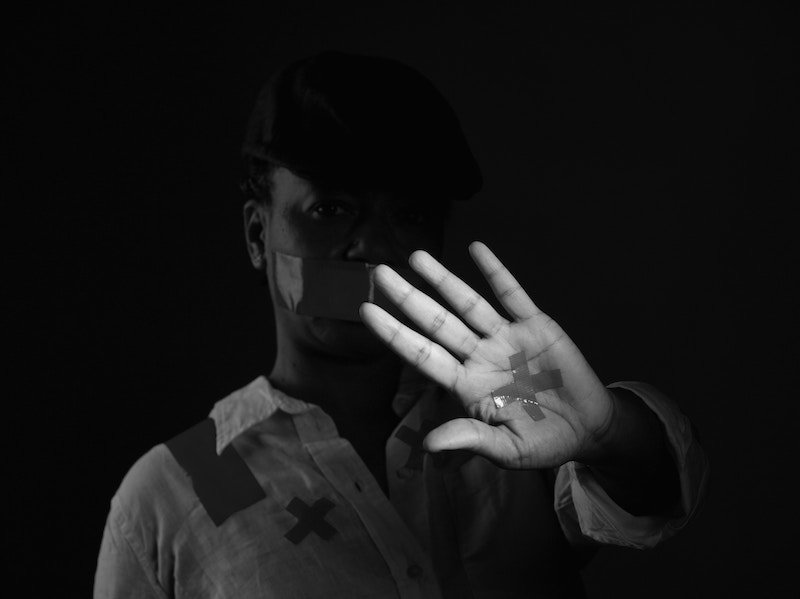Anastacia-Reneé Tells the Story of a Queer Black Woman
Review of Anastacia-Reneé's (Don’t be Absurd) Alice in Parts presented by Frye Art Museum
Written by Teen Writer Alyssa Williams and edited by Teen Editor Lucia McLaren

Anastacia-Reneé’s exhibit at the Frye Museum, (Don’t be Absurd) Alice in Parts, tells the story of her character, Alice Metropolis, who is a queer Black woman living in a neighborhood that’s in the process of gentrification. The exhibit tells its story through furniture, objects, poems, and short video clips. Alice has breast cancer, a story element that sheds light on the inequities of medical treatment based on race. Not only does Alice fight cancer of the body, but she also fights cancer of the mind: white supremacy and racism.
One part of the exhibit that stuck with me long after the show was a short clip of Alice holding a bottle of alcohol and talking to the camera. She talks about how when she goes through tragedies and unimaginable hardships in life because of her race, she has to just “keep it moving.” This speaks to society’s expectation for Black women to be caretakers in the home, in society, in the Black Lives Matter movement—to care for everyone but themselves and never slow down. The bottle of alcohol symbolizes how these standards damage her mental health and cause her to be in desperate need of a break.
At the end of the exhibit, Alice dies from cancer. There is no victory in Alice’s story. Her story sends a message about how we as a society have failed Black women, how receiving support has to be destigmatized, and that we have to give more support to each other. Alice physically died from cancer, but she also symbolically died from facing the cancer of white supremacy and racism without the support that she needed. (Don’t be Absurd) Alice in Parts is not just Alice’s story. It’s the story of many Black women living in America today.

After virtually visiting the exhibit, I listened to Anastacia-Reneé and her team discuss the exhibit and its messages (this discussion is available on the Frye Art Museum YouTube channel). Her team is a wonderful group of Black women who are deeply in touch with today’s societal issues, so listening to them was an eye-opener for me. They said that Anastacia-Reneé’s work represents the words that Black women fear to say in public today. These words are about how people treat Black women like puppets and make decisions for them and define how they should act. These words are about the expectation for Black women to be “strong” and get through everything on their own without struggling. These words are about not feeling safe in their own home.
Despite their struggles, they also talked about having hope, finding support among each other, experiencing joy in their hobbies and in life, and continuing to fight back. When asked “when the fight (for racial justice) is over,” one team member responded saying that the fight won’t end until people like Alice can go to sleep at night not wondering if they’ll become the next hashtag (a reference to Black victims of police killings), and until they can go out in public bringing their full self and not worrying about retribution. We have a long way to go as a community, but I believe that this exhibit is a message of hope for the future.
This exhibit and its messages around affordable housing, police brutality, and gentrification are especially important in the perspective of recent events, such as the Black Lives Matter movement, the storming of the capital by white supremacists, and the inequities and discrimination in America based on race, class, gender, or ability becoming more apparent. The exhibit was wonderfully put together and made me think deeply about where we are as a society with respect to race. I highly recommend this exhibit to those who want to better understand the struggle of living as a Black woman today.
(Don’t be Absurd) Alice in Parts is available to view at the Frye Art Museum from January 30 - April 25, 2021. For more information see here.
Lead photo credit: Anastacia-Reneé. Alice in Parts (video still), 2016. Digital video (black and white, sound) 30:36 min. Courtesy of the artist.
The TeenTix Newsroom is a group of teen writers led by the Teen Editorial Staff. For each review, Newsroom writers work individually with a teen editor to polish their writing for publication. The Teen Editorial Staff is made up of 6 teens who curate the review portion of the TeenTix blog. More information about the Teen Editorial Staff can be found HERE.
The TeenTix Press Corps promotes critical thinking, communication, and information literacy through criticism and journalism practice for teens. For more information about the Press Corps program see HERE.

